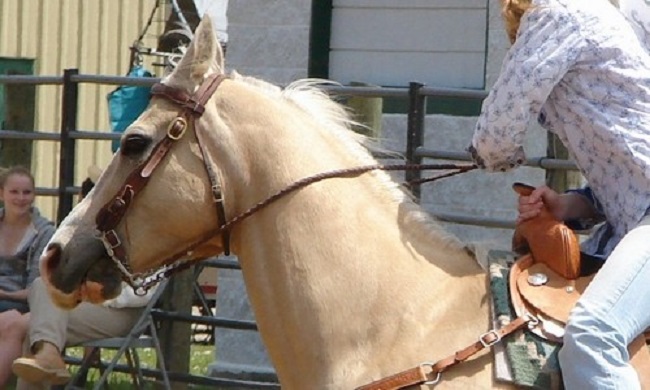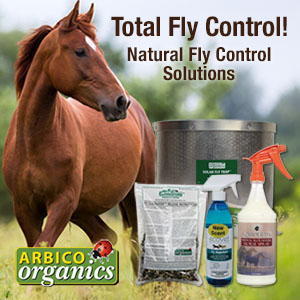
The functions of neck reining are refinements of the horse responding to following the feel of pressure and movement away from pressure more than from their response to pressure applied to the poll and tongue thru the bit and bridle. These are functions, as with other tasks of education, begin in small steps and proceed on an incremental basis. First, let us explore the difference between direct reining and neck reining.
Direct Reining
Direct reining is like walking your pet on a leash or lead, i.e., pull in one direction and the pet will follow. Neck reining is like the art of backing up a trailer hooked to your tow vehicle. It almost seems contrary to common sense and is a skill that needs to be learned. With a rein in each hand of the rider it allows them to contact the horse’s mouth with a simple direct pulling type motion. Once the horse responds to the feel of the pull and begins to flex their neck their body has the natural reaction to follow the movements of where the head is placed.
Necking Reining
This opposes the direct-rein concept in that the horse must be taught to ignore their natural reaction to lean into pressure and to move away from the feel of the active, pressure giving rein and move in the direction of looser and opposite rein. Neck-reining has its roots in Spain and Mexico. It is used more in the West where horseman need to have a hand free to open gates, toss a rope and to perform a host of chores more readily than with having both hands committed to the reins. It takes additional effort to accomplish neck reining but has added value. It allows your horse to become a lot more functional in many riding circumstances and endeavors. It is not a skill learned all at once and it takes continual practice to perfect it to the point where all neck rein cues appear to be almost nonexistent to the observer.
Neck reining techniques can be taught to horses of any age. The entire concept of teaching it can be broken down into two steps: teaching and correcting. First, begin by laying one of your two reins along the side of your horse’s neck so they can feel the pressure of that rein. If the horse does not move away from that pressure reach your hand down along the rein on the other side (the side which you choose to have the horse move) and lightly put pressure on that rein while placing more pressure on the rein that is laying against the horse neck. As soon as the horse begins to move in the correct direction release the pressure from both of your hands at the same time instantly putting slack into both the reins. Adjust your body in a neutral upright position with equality in your entire body and seat bones. Always begin this education on the side of your horse’s preferred direction and keep repeating the lesson with short breaks between requests.
Observe your horse during the lesson. Look for a lowering of the head, licking of the lips and/or grinding of the teeth. These are acknowledgements from the horse that they understand your request. Continue repeating the request, on the horse’s side of strength and direction, using less pressure as each repetition should yield movement from the horse with less pressure. Then repeat the entire lesson on the horses’ weaker side. Try to accomplish this with little or no leg prompts or cues. Use your legs only to support their movements. Apply pressure slowly and take it away quickly, direct the horse with one hand and one leg and support their move with the opposing hand.
I begin teaching a horse this by walking in a circle about ten to fifteen feet in diameter. Be insistent on receiving a proper response but do not look for refinement while you are in the teaching/beginning phase. Remember all horses learn thru four phases; 1. Teach, 2. Control, 3. Reinforce, 4. Refine. The equipment used for this type of training can be a set of mecate reins with a bosal or a natural horseman halter with the reins attached to the halter. If you choose to do so, you can use your bridle with a snaffle bit or even a leverage bit, however, keep in mind you want to ultimately reach the point where both reins are in one hand and little or no pressure is placed on your horses’ mouth. It is important to keep your body always balanced and centered over your horse. Advance your skills and your equipment to the point where you will finally be using the headstall and bit that you will be showing in or using for type of riding that you do. Keep repeating your rein signal on a consistent basis and respond quickly with their reward which is slack in the reins.
Practice, patience, and persistence will yield the pleasures of a neck reining horse. Use and perfect your techniques every time you ride and warm up your horse as it needs constant reinforcement to become perfect. Take the time it takes to perfect the skill and it will take less time in the overall scheme of things to accomplish your goals in all horse education.
Provided by Dan Kuhn Natural Horseman Services
Crazy Horse Laws Still on the Books
A Wyoming community passed this one: “No female shall ride a horse while attired in a bathing suit within the boundaries of Riverton, unless she be escorted by at least two officers of the law or unless she be armed with a club.” And continues with this amendment to the original: “The provisions of this statute shall not apply to females weighing less than ninety pounds nor exceeding two hundred pounds.”
Male horse buffs in Basalt, Nevada, are prohibited from eating onions between the hours of 7 a.m. and 7 p.m. while out riding. The law specifies only men.
Related Articles & Free Email Newsletter Subscription
How & When to Halter Train a Foal
How to Teach a Horse to Ground Tie
How to Train a Horse to Not Shy Away from Objects




Comment here